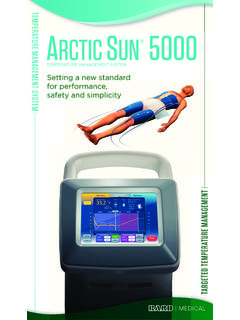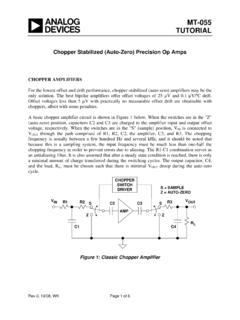Transcription of CN-0287 (Rev. B) - Analog Devices
1 Circuit Note CN- 0287 Circuits from the Lab reference designs are engineered and tested for quick and easy system integration to help solve today s Analog , mixed-signal, and RF design challenges. For more information and/or support, visit Devices Connected/Referenced AD7193 4-Channel, kHz, Ultralow Noise, 24-Bit Sigma-Delta ADC with PGA ADT7310 C Accurate, 16-Bit Digital SPI Temperature Sensor AD8603 Precision Micropower, Low Noise CMOS R-to-R Input/Output Operational Amplifiers ADR3440 V, Micropower High Accuracy Voltage Reference ADG738 CMOS, Low Voltage, 3-Wire Serially-Controlled, Matrix Switch ADG702 CMOS Low Voltage 2 SPST Switch AD5201 33-Position Digital Potentiometer ADuM1280 3 kV RMS Dual Channel Digital Isolators ADuM5401 Quad-Channel, kV Isolators with Integrated DC-to-DC Converter Isolated 4-Channel, Thermocouple/RTD Temperature Measurement System with C Accuracy Rev. C Circuits from the Lab reference designs from Analog Devices have been designed and built by Analog Devices engineers.
2 Standard engineering practices have been employed in the design and construction of each circuit, and their function and performance have been tested and verified in a lab environment at room temperature. However, you are solely responsible for testing the circuit and determining its suitability and applicability for your use and application. Accordingly, in no event shall Analog Devices be liable for direct, indirect, special, incidental, consequential or punitive damages due to any cause whatsoever connected to the use of any Circuits from the Lab circuits. (Continued on last page) One Technology Way, Box 9106, Norwood, MA 02062-9106, Tel: Fax: 2013 2014 Analog Devices , Inc. All rights reserved. EVALUATION AND DESIGN SUPPORT Circuit Evaluation Boards CN- 0287 Circuit Evaluation Board (E VAL-CN0287-SDPZ) System Demonstration Platform (EVAL-SDP-CB1Z) Design and Integration Files Schematics, Layout Files, Bill of Materials CIRCUIT FUNCTION AND BENEFITS The circuit shown in Figure 1 is a completely isolated 4-channel temperature measurement circuit optimized for performance, input flexibility, robustness, and low cost.
3 It supports all types of thermocouples with cold junction compensation and any type of RTD (resistance temperature detector) with resistances up to 4 k for 2-, 3-, or 4-wire connection configurations. The RTD excitation current are is programmable for optimum noise and linearity performance. RTD measurements achieve C accuracy (typical), and Ty p e-K thermocouple measurements achieve C typical accuracy because of the 16-bit ADT7310 digital temperature sensor used for cold-junction compensation. The circuit uses a four-channel AD7193 24-bit sigma-delta ADC with on-chip PGA for high accuracy and low noise. Input transient and overvoltage protection are provided by low leakage transient voltage supressors (TVS) and Schottky diodes. The SPI-compatible digital inputs and outputs are isolated (2500 V rms), and the circuit is operated on a fully isolated power supply. CN- 0287 Circuit Note Rev. C | Page 2 of 9 Figure 1. 4-Channel Thermocouple and RTD Circuit (Simplified Schematic: All Connections and Decoupling Not Shown) CIRCUIT DESCRIPTION Temperature Measurement Introduction Thermocouples and RTDs (resistance temperature detectors) are the most frequently used sensors for temperature measurement in industrial applications.
4 Thermocouples are able to measure very high temperatures up to about +2300 C and also have a fast response time (measured in fractions of a second). RTDs are capable of higher accuracy and stability than thermocouples, and the resistance of long wire lengths (hundreds of meters) to a remote RTD can be compensated for with 3- or 4-wire connections. A thermocouple consists of two wires of different metals joined at one end. This end is placed at the temperature which is to be measured, refered to as the measurement junction. The other end is connected to a precision voltage measurement unit, and this connection is referred to as the reference junction or alternately the cold junction. The temperature difference between the measurement junction and the cold junction generates a voltage (known as the Seebeck effect voltage) that is related to the difference between the temperatures of the two junctions. The signal generated is typically from several microvolts to tens of millivolt depending on the temperature difference.
5 For example, K-type thermocouples are capable of measuring 200 C to +1350 C with an output range of approximately 10 mV to +60 m V. It is important for the signal chain to maintain as high impedance and low leakage as possible to achieve the highest accuracy for the voltage measurement. In order to convert this voltage to an absolute temperature, the cold junction temperature must be accurately known. Traditionally 1 C to 2 C has been considered sufficient, although since the cold junction measurement error contributes directly to the absolute temperature error, a higher accuracy cold junction temperature measurement is beneficial An RTD is made from a pure material, such as platinum, nickel or copper, that has a predictable change in resistance as the temperature most widely used RTD is platinum (Pt100 and Pt1000). One method used to accurately measure the resistance is to measure the voltage across the RTD generated by a constant current source. Errors in the current source can be cancelled by referring the measurement to the voltage generated across a AD7193 REFIN2( )REFIN2(+) +5V300 300 300 300 300 300 300 300 300 1nF1nF+5V+5V27nF1nF1nF+5V+5V+5V+5V+5V+5V 27nFDSINADG7021k R3C2C2C2S1S2S7S8 SCLKDDINSYNCADG738 DOUTPWR-ONPRESETAWBSHDNVDDVSSCSCLKSDIGND AD5201 LOGICCONTROL+5V+ P3 ADR3440 VOUTFORCESENSEFORCESENSEGND+5 VREFIN1(+)REFIN1(0)+ JUNCTION COMPENSATIONSCLKGNDCSADT7310_CSSCLKDINAD G738_CSSCLKDOUTDINCSSCLKDOUTDINAD7193_CS DGNDAGND+5 VSCLKDIN+5V+5VV V+ F10 F+5 VAINCOMAIN4 AIN3 AIN6 AIN5JP112312312341234JP4+5 VTHERMOCOUPLE:RTD 2,3 WRTD 4 WCH 1CH + DIODE0 : Analog GROUND.
6 DIGITAL GROUNDDVDDAVDDGND1 GNDISO+5 VISOVDD1 GND2 VDD2 VIAVIBVOAVOBADuM1280+5 VCTINTCTISOINTISOGNDISOGND2 VDD2 GND1 VDD1 VOAVOBVIAVIB+5 VISO+5 VADuM1280 ADT7310_CSADG738_CSADT7310_CSISOADG738_C SISOSCLKDOUTDINADuM5401AD7193_CSAD7193_C SISOGNDISODINISOSCLKISODOUTISOGNDISOVDD1 VISOGND1 VOAVOAVOCVIDVIAVIBVICVOD+5 VISO+5V10926-001 Circuit Note CN- 0287 Rev. C | Page 3 of 9 reference resistor that is driven with the same current ( a ratiometric measurement). Minimizing the leakage current through the current path is important for achieving high accuracy because the excitation current is typically only a few hundred microamps to prevent self heating. For the industrial field applications both high performance as well as protection against both high-voltage transient events and dc over-voltage conditions are important design considerations. How this Circuit Works The circuit shown in Figure 1 is designed for precision temperature measurement applications in the industrial field environment and is optimized for flexibility, performance, robustness, and cost.
7 This circuit uses the AD7193, low noise, 24-bit sigma-delta ADC to ensure high resolution and linearity for the entire circuit. The AD5201, 33-position digital potentiometer, AD8603 op amp, and ADG702 single channel switch constitute a simple programmable current source and bias voltage buffer for the RTD and thermocouple measurements. The ADG738 routes the current source to the active RTD channel and allows wire resistance compensation for the 3-W RTD configuration. The ADT7310 digital SPI temperature sensor has C maximum accuracy (+5 V supply) from 40 C to +105 C and is used for cold-junction compensation for the thermocouple measurement. The ADR3440 is a low noise and high accuracy V reference connected to REFIN1(+)/REFIN1( ) of the AD7193 for the thermocouple measurements. Analog -to-Digital Converter The AD7193 is a low noise, complete Analog front end for high precision measurement applications. It contains a low noise, 24-bit sigma-delta ( - ) Analog -to-digital converter (ADC).
8 This ADC achieves high resolution, low non-linearity, and low noise performance as well as very high 50 Hz/60 Hz rejection. The data output rate can be varied from Hz (24 bits effective resolution, Gain = 1), to kHz ( bits effective resolution, Gain = 1). The on-chip low noise PGA amplifies the small differential signal from the thermocouple or RTD with a gain programmable from 1 up to 128, thereby allowing a direct interface. The gain stage buffer has high input impedance and limits the input leakage current to 3 nA maximum. The gain of theAD7193 must be configured properly depending on the temperature range and type of sensors. The on-chip multiplexer allows four differential input channels to be shared with the same ADC core, saving both space and cost. Programmable Current Source for RTDs and Bias Voltage Generator Circuit for Thermocouples RTD measurements require a low noise current source that drives the RTD and a reference resistor. Thermocouple measurements, on the other hand, need a common-mode bias voltage that shifts the small thermocouple voltage into the input range of the AD7193.
9 The circuit shown in Figure 2 meets both requirements and utilizes the AD8603 a low noise CMOS rail-to-rail input/output op amp with only 1 pA maximum input bias current and 50 V maximum offset voltage, combined with the ADG702 single channel, CMOS low voltage 2 SPST switch, and the ADG738 eight-channel matrix switch. Figure 2. External Programmable Current Source and Bias Voltage Generator With the ADG738 opened and the ADG702 closed, the AD8603 acts as a low noise, low output impedance unity-gain buffer for the thermocouple application. The voltage from the AD5201 digital potentiometer is buffered and is used for the thermocouple common-mode voltage, usually V, which is one-half the supply voltage. The 33-position AD5201 digital potentiometer is driven with the ADR3440 low drift (5 ppm/ C) V reference for accuracy. With the ADG738 closed and the ADG702 opened, the AD8603 generates the RTD excitation current, IEXC = VW/RREF. AD7193 REFIN2( )REFIN2(+)AIN2 AIN1 DSADG7021k R3C2DS1 ADG738 AWBAD5201+ +5 VRTDTCVWIEXCIEXC=VWRREFRREF10926-002CN-0 287 Circuit Note Rev.
10 C | Page 4 of 9 Temperature measurement is a high precision and low speed application, therefore there is adequate settling time available to switch the single current source between all 4 channels, providing excellent channel-to-channel matching, low cost, and small PCB footprint. The ADG738 is an 8-to-1 multiplexer that switches the current source between channels. In order to support the 2-, 3-, and 4-wire RTD configurations, each of the four channels need two switches. In many applications, the RTD may be located remotely from the measurement circuit. The resistance from the long lead wires can generate large errors, especially for low resistance RTDs. In order to minimize the effect of the lead resistance, a 3-wire RTD configuration is supported as shown in Figure 3. Figure 3. Connector and Jumper Configuration for3-Wire RTD Sensor With S1 of the ADG738 closed and S2 opened, the voltage at the input of AD7193 is V1. With S1 opened and S2 closed, the voltage on the input of AD7193 is V2, The voltage across the RTD sensor is VRTD, the exciting current from the current source is IEXC.














